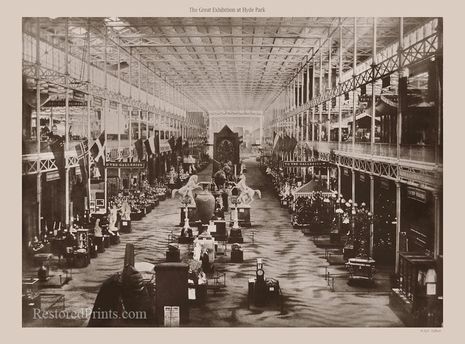How could we forget? The British Empire, imagination and collective amnesia
Roshni Parmer-Hill explores the symbolic side of the British Empire and how it was sold to a nation’s imagination, arguing that an overly iconographic memory of empire omits its more brutal realities.

When we speak of the British Empire, when we discuss its legacies, effects and continuing manifestations, what are we referring to? A vague feeling of white guilt, jingoistic pride and unarticulated rage pervade a shaky and unexamined definition of the British Empire. A definition that is built from a foundation of collective historical amnesia and continues to silence the voices of the people who have lived, and continue to live, under the weight of imperialism. But we need to be specific: if we want to ‘come to terms with empire’ we need to evaluate and criticise the foundations in which empire was conceived in Britain.
"The sites of the imagination were created through imperial products, which became the popular symbols of the British Empire."
For many, the empire has always been a symbol. A symbol in the sense that the acts of colonialization, extraction and even slavery were primarily understood through secondary objects. For a great deal of the time since Britain has profited off colonialism, the vast majority of British people did not travel beyond the island’s white cliffs, confining their interaction with empire to the songs they sang, the stories they read and the packaging they saw on the front of tea boxes. This may seem like a banal observation, a general fact known to every over-sixty year old who used to shop in ‘Empire Stores’, but the repercussions of this shallow, iconographic interaction with Empire is part of the reason why Britain suffers from historical amnesia, and why we need to question the pervasive Anglocentric view.
At its height, the British Empire had control over 24% of the globe with colonies spread from New Zealand to Canada. Such an expanse, funded by the profits of slavery and extraction, was inconceivable to most British people. Even the main administrators of the Empire, who sat in the wood-panelled offices and wore sand-coloured pith helmets, were from selective families from the upper and middle classes. The obscurity of this profession was mystified in Britain as the memories of Nabobs from the East India Trading Company gave them a distinct, if not isolated place in British society. But for most, empire and its symbolic presence was understood through the imagination.
The sites of the imagination were created through imperial products, which became the popular symbols of the British Empire. Collected, housed and shown-off in the ‘Great Exhibition’ of 1851, the commercial communication of empire began to expand rapidly into children’s magazines, showcases, and a vast Empire Exhibition in 1924-25. Much has already been said about how these developments created popular support for the Empire, but it was ‘products’ as the site of imagination that affected the parameters in which empire was conceived. Even at the height of imperialism and jingoistic narratives, Empire was a concept that was sanitised and anglicised – presented through particular and calculated terms that ensured commercial success.
Magazines, exhibitions and songs created a structure that made imperialism conceivable and consumable to the general British public. In reality, the Empire was far more than a stock image, British imperialism manifested in innumerable ways, convulsing and adapting to each exploit to the extent where there was, and is, no one definition of the British Empire. But as an imaginary construct founded on select symbols, in Britain, empire was defined, recognised and reduced to a gross simplicity.
"To understand empire there needs to be a decoding of what we mean by it."
These imaginary parameters that contained the British Empire were overtly politicised in the imperial articulations of Disraeli, and later in the justification of the colonisation of Africa. It became the state’s concern in 1926 to encourage Empire Trade; the Empire Marketing Board plastered romanticised images of ‘Our trade with the East.’ It became a common trope on popular branding, such as Lipton’s Tea and P&O cruises, to exotiticise the ‘Oriental other’ as part of the desirability for their products. Empire was a term, a selling point, a niche, a popular aesthetic, and it is this simplicity that would allow Empire to be easily wiped away.
After the wave of decolonisation movements, and a shift in empire’s place in the public imagination, in the mid-twentieth century, the profitability of empire as a symbol quickly died away, and the images that adorned popular products and goods died with it. With the word ‘Empire’ erased from popular sites - such as Wembley Stadium, formally known as Empire Stadium – and the imperial magazines out of print, imperialism was quick to become distorted in memory. The ease in which this occurred was because empire was never fully realised in the popular imagination, Empire was only in name. Imperialism, for the British, was figurative, imaginary, abstract and based on the symbolic.
Empire can be easily omitted if it is only a word, only an image. But for those who came to Britain under colonialism, whose heritage lies in the structures of domination and exploitation, empire was always far more than a word, it was, and is, a living trauma.
Tackling historical amnesia is not a process of ‘coming to terms with Empire’ because the terms in which empire was defined were superficial, essentialised and pejorative. To understand empire there needs to be a decoding of what we mean by it. We need to understand that it is not just a term, or an assessed subject in history, but a structure of power that permeated people’s lives and family history.
Debates around the British Empire are focused on the condemnation of the oppressors, be that in the form of Edward Colston or Cecil Rhodes. However, bringing justice to the past cannot be fulfilled through a myopic focus on the British who defined the Empire in rhetoric, rather than reality. To truly understand the past and present modes of empire is to listen to those who were subject to it, to shift the focus onto the narratives of the real people behind the products, and to find the lives that never ‘forgot’ the true nature of imperialism.
 Comment / Plastic pubs: the problem with Cambridge alehouses 5 January 2026
Comment / Plastic pubs: the problem with Cambridge alehouses 5 January 2026 News / Cambridge academics stand out in King’s 2026 Honours List2 January 2026
News / Cambridge academics stand out in King’s 2026 Honours List2 January 2026 News / Cambridge businesses concerned infrastructure delays will hurt growth5 January 2026
News / Cambridge businesses concerned infrastructure delays will hurt growth5 January 2026 News / AstraZeneca sues for £32 million over faulty construction at Cambridge Campus31 December 2025
News / AstraZeneca sues for £32 million over faulty construction at Cambridge Campus31 December 2025 Interviews / You don’t need to peak at Cambridge, says Robin Harding31 December 2025
Interviews / You don’t need to peak at Cambridge, says Robin Harding31 December 2025










